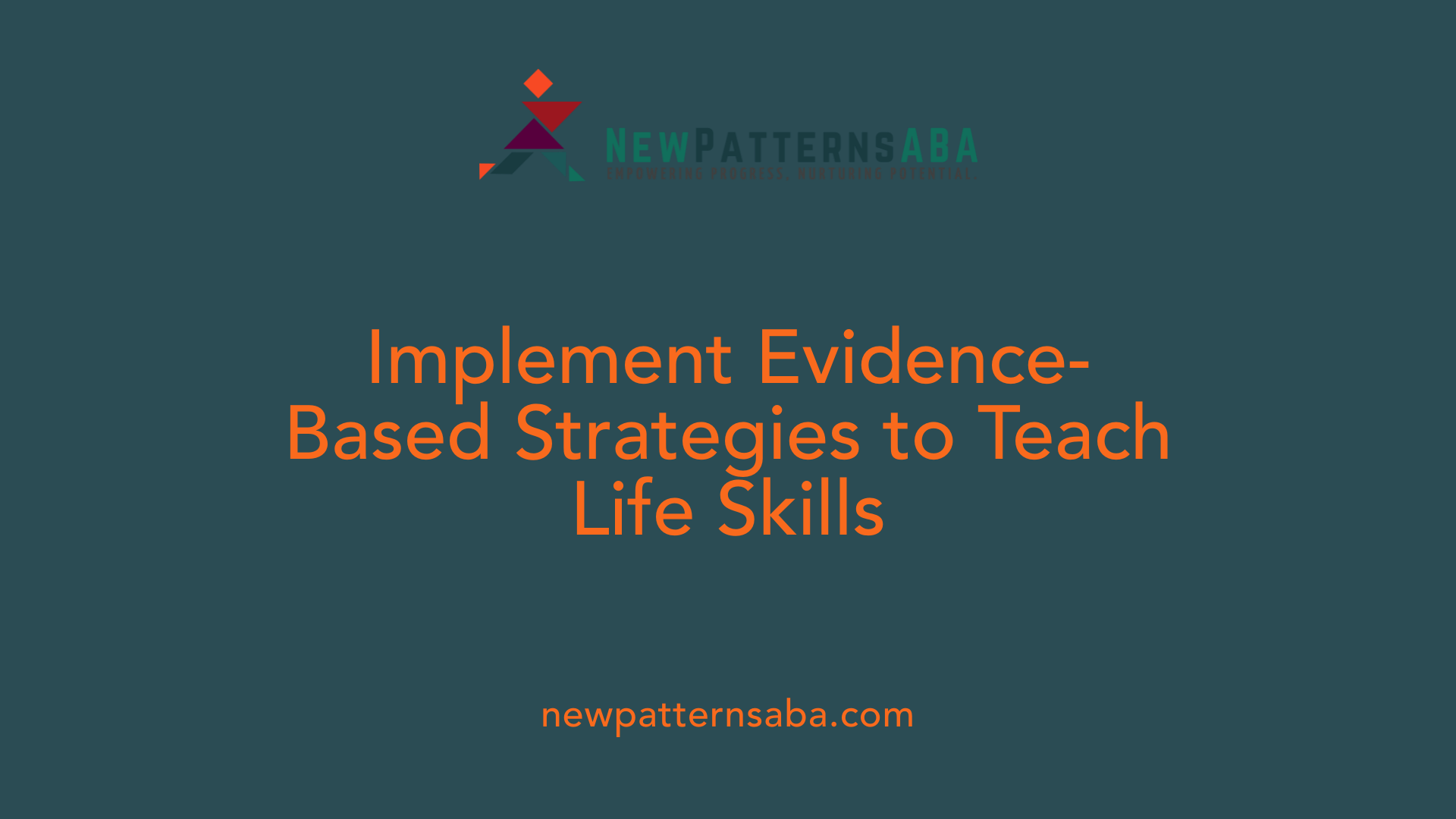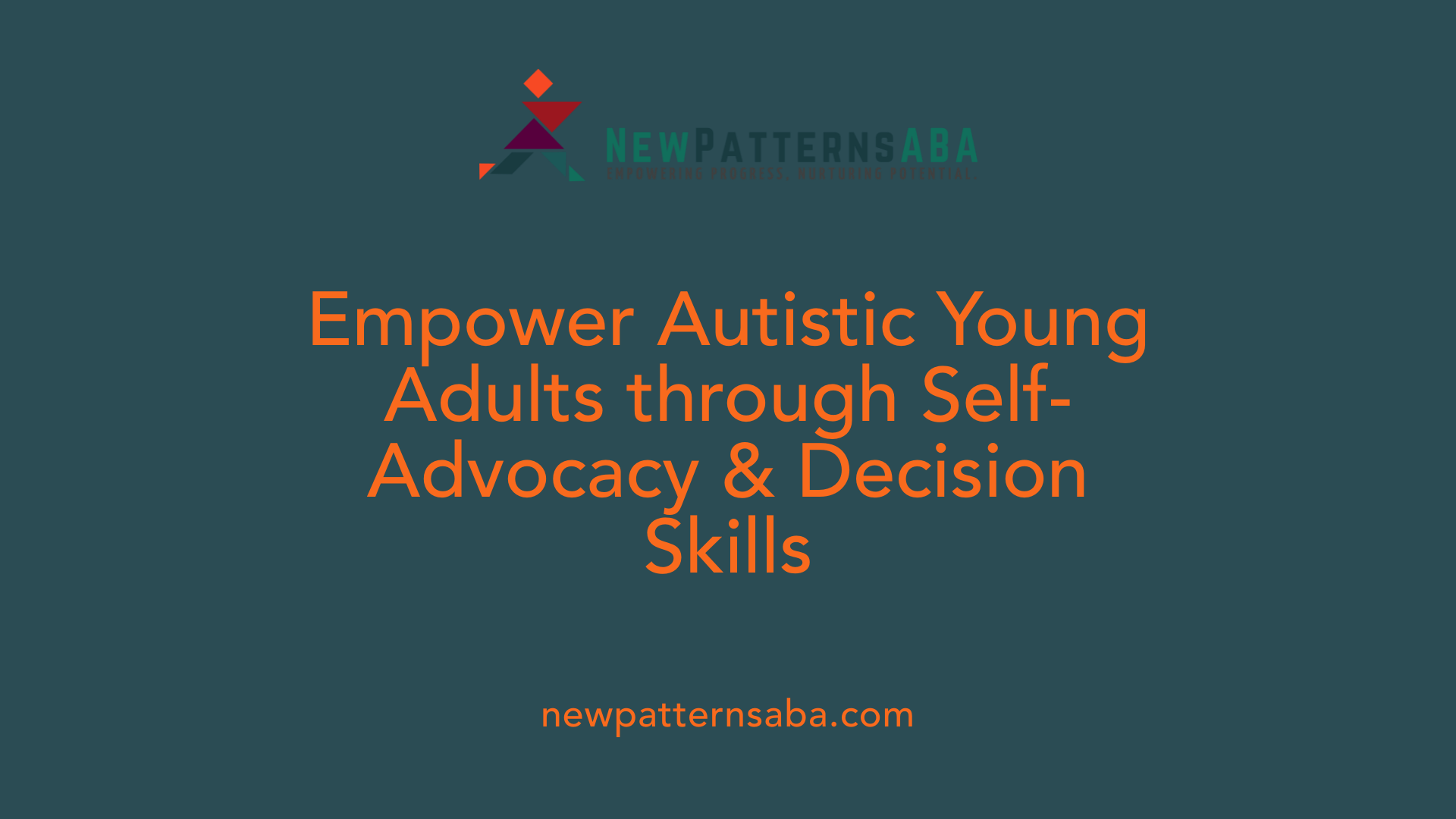Empowering Autistic Young Adults for Autonomy and Self-Sufficiency
Understanding the Foundations of Independence in Autism
Promoting independence among autistic young adults is a crucial aspect of their development and well-being. It involves equipping them with practical skills and confidence to navigate daily life confidently across educational, home, and community settings. Tailored interventions, structured routines, visual supports, and community resources form the backbone of effective independence building. Recognizing individual strengths, preferences, and needs ensures that these strategies are personalized and impactful, ultimately fostering self-determination and lifelong self-sufficiency.
Integrating Communication and Visual Supports to Enhance Self-Expression and Routine Management

What are the best practices for supporting independence in educational, home, and community settings?
Supporting independence requires creating structured environments that promote predictability and security. Using consistent routines helps individuals anticipate daily activities, reducing anxiety and increasing confidence.
Offering choices throughout daily routines empowers individuals to make decisions, boosting their autonomy and decision-making skills. For example, allowing a young adult to choose between two activities or select their clothing encourages independence.
Engagement in functional activities, such as household chores, shopping, or helping in community settings, fosters responsibility and social skills. These activities also promote a sense of accomplishment and self-worth.
Incorporating visual supports, like picture schedules, social stories, and checklists, makes information accessible and helps manage transitions smoothly. Clear, visual cues are especially beneficial for learners with autism, facilitating understanding and independence.
Positive reinforcement, patience, and gradual skill-building are essential components. Respecting each individual’s unique interests and strengths allows for personalized approaches that are more effective.
Leveraging technology—such as apps for task management or communication devices—further supports independence. Support should be adaptable, with ongoing assessment and adjustments based on progress.
By fostering independence across all settings, caregivers and professionals help autistic individuals develop essential life skills, leading to increased self-sufficiency and well-being.
What resources and guidance are available for educators, caregivers, and support providers to promote independence in autistic young adults?
Numerous resources support the development of independence in autistic young adults. Specialized training programs focus on life skills, communication, and behavioral strategies.
Community-based services, such as vocational training centers, employment programs, and housing supports, facilitate real-world skill application. For instance, organizations like Easterseals and Autism Housing Network provide tailored services for transition-age youth.
Educational tools like visual schedules, 'to do' lists, and task analysis break down complex activities into manageable steps, enabling individuals to learn at their own pace.
Assessment tools like the Community-Based Skills Assessment (CSA) help identify current skills and guide target areas for growth. These assessments support personalized planning.
Support providers often utilize online resources, webinars, and instructional materials from organizations such as the Autism Society or the National Autistic Society. These materials offer strategies for implementing routines, fostering self-advocacy, and promoting community engagement.
Collaboration among educators, caregivers, and professionals ensures consistency and reinforcement across environments. Continuous training and evaluation adapt strategies to evolving needs.
Overall, a combination of targeted training, practical tools, community resources, and ongoing support helps empower autistic young adults to achieve greater independence.
Using Visual Supports and Structured Routines to Foster Autonomy

What practical tools and methods support independent living and working skills for autistic young adults?
Supporting independence in autistic young adults involves a variety of practical tools and teaching methods. Visual supports such as schedules, choice boards, and ‘to do’ lists help clarify routines and organize tasks. These tools guide individuals through daily activities, reducing confusion and increasing confidence. Communication aids like augmentative and alternative communication (AAC) devices, picture exchange systems, and sign language enable expression of preferences, requests for breaks, and social interaction. Step-by-step task analysis is particularly useful for teaching complex activities, such as household chores, shopping, or self-care routines, breaking them into manageable parts. Teaching practical skills also includes managing money—understanding currency, making transactions, and using digital banking—and navigating community safety and transportation. Vocational training, role-playing, and modeling promote job readiness and responsibility. Support programs, goal-setting techniques, and self-monitoring tools empower individuals by fostering independence and confidence. By combining these strategies, caregivers and professionals can help autistic young adults develop essential life skills for at-home, school, and community environments.
Community Programs and Resources Driving Independence
 Supporting independence in autistic young adults involves a range of community programs and tailored resources designed to foster essential life skills. These include supported living services, various housing options, and employment support mechanisms provided through initiatives like the Self-Determination Program (SDP). The SDP empowers individuals to choose their supports and manage funding, enabling more personalized and autonomous living arrangements.
Supporting independence in autistic young adults involves a range of community programs and tailored resources designed to foster essential life skills. These include supported living services, various housing options, and employment support mechanisms provided through initiatives like the Self-Determination Program (SDP). The SDP empowers individuals to choose their supports and manage funding, enabling more personalized and autonomous living arrangements.
Community-based skills assessments and coaching services are vital tools in this process. Instruments such as the Community Skills Assessment (CSA) evaluate a person's current abilities, helping developers tailor programs that meet individual needs. Digital resources, online workshops, and checklists support ongoing learning and transfer of skills across environments.
Innovative strategies also play a significant role. For example, SWAT Support—an embedded teaching method—has proven effective in increasing independence during community activities. It involves brief vocal instructions, gestures, and physical guidance when necessary, to support individuals in completing tasks in settings like grocery stores, jobs, or office environments. Studies have shown that even minimal training allows staff to implement SWAT Support successfully, leading to measurable improvements in task independence.
What community programs and support services can facilitate the development of independence in autistic young adults?
Community programs and support services are instrumental in developing independence among autistic young adults. They provide targeted skill development in areas such as self-care, money management, transportation, and health routines. Visual aids—like checklists, schedules, and social stories—make routines predictable and manageable, easing transitions and reducing anxiety.
Programs like the Self-Determination Program (SDP), Centers for Independent Living, and local community supports offer options for affordable and supportive housing, employment opportunities, and community participation. These programs emphasize personal choice and self-advocacy, helping individuals take control of their lives.
Moreover, innovative approaches like SWAT Support—where staff support individuals through vocal cues, gestures, and physical guidance—have demonstrated success. This method quickly enhances independence in real-world settings, with minimal training required for support staff.
How can visual aids, structured routines, and teaching strategies enhance independence among autistic young adults?
Visual supports—such as schedules, choice boards, and social stories—are essential tools for helping autistic young adults understand routines and social expectations. These visuals provide predictability, reduce anxiety, and strengthen communication, especially for those using augmentative and alternative communication (AAC) methods.
Structured routines broken into clear, manageable steps enable individuals to perform daily tasks like dressing, cooking, or organizing their space with less adult assistance. This structure promotes self-confidence and self-sufficiency.
Teaching strategies include explicit instruction, modeling, and practicing skills in realistic environments. These approaches help develop independence in community navigation, shopping, and vocational tasks. Importantly, routine practice and the use of visual aids support skill generalization across different settings, fostering lifelong independence.
Resources to Enhance Community-Based Independence Development
| Resource Type | Description | How It Supports Independence |
|---|---|---|
| Community Skills Assessment (CSA) | Tool for evaluating individual skills | Helps create personalized skill development plans |
| Self-Determination Program (SDP) | Funding and support customization | Fosters choice and control in living, employment, and support options |
| Supported Living and Housing | Various options for housing support | Promotes autonomous living in a safe, supportive environment |
| Digital Resources & Checklists | Online tools, tutorials, visual schedules | Reinforce daily routines and aid skill transfer |
| SWAT Support | On-the-spot embedded teaching strategy | Increase independence in real-world community tasks |
| Vocational and Employment Services | Job coaching, skill training | Prepare for and support community-based employment |
| Community Navigation Support | Travel training, orientation programs | Teach safe navigation, public transportation use |
| Summer Programs & Social Camps | Recreational and social skill development | Enhance social skills, independence, and confidence |
In conclusion, integrating community programs, personalized assessments, and innovative teaching methods—such as SWAT Support—can significantly boost independence in autistic young adults. Visual aids, structured routines, and community-based supports create an environment where individuals are empowered to lead more autonomous and fulfilling lives.
Teaching-Life Skills with Evidence-Based Techniques

What interventions and educational approaches are tailored for promoting independence in autistic young adults?
Promoting independence in autistic young adults requires tailored, evidence-based strategies that address their individual needs and strengths. One widely used approach is Applied Behavior Analysis (ABA) therapy, which emphasizes teaching functional life skills such as hygiene, communication, and self-care while reducing behaviors that interfere with daily living.
Educational methods incorporate visual supports like checklists, visual schedules, and task analysis tools. These supports help individuals understand routines, break down complex tasks into manageable steps, and promote independence in environments like home, school, and community settings.
Strengthening communication is fundamental. For individuals with speech challenges, augmentative and alternative communication (AAC) methods—including PECS (Picture Exchange Communication System), speech devices, and sign language—allow expression of preferences and feelings. This boosts self-advocacy and decision-making.
Practical skills such as money management, community safety, household chores, and vocational training are central to fostering real-world independence. For example, teaching how to handle money, use public transportation, or perform household tasks prepares young adults for community participation.
Innovative, embedded teaching strategies like SWAT Support involve quick prompts and physical guidance to support task completion in community activities such as shopping or working. Studies indicate that such support increases independence with minimal training for staff, is quick to implement, and leads to lasting improvements in everyday functioning.
What approaches are effective for teaching life skills such as organization, community participation, and self-care to autistic young adults?
Teaching these crucial skills effectively combines hands-on experiences with visual and environmental supports. Utilizing natural environment teaching means practicing skills in real-life settings—like cooking in the kitchen, shopping in stores, or navigating public transit—making learning relevant and sustainable.
Visual supports play a vital role. Checklists for daily routines, visual schedules for transitions, and social stories help clarify expectations and sequence actions. These tools promote independence and reduce anxiety during routines.
Community participation is encouraged through direct involvement in activities such as grocery shopping, using public transportation, or attending recreational events. These opportunities allow autistic young adults to generalize skills across various settings and build confidence.
Assessment tools like the Community-Based Skills Assessment (CSA) help identify specific strengths and challenges, allowing educators and caregivers to tailor instructional strategies. Programs often focus on developing executive functioning, self-determination, and social communication through activities, coaching, and peer interactions.
Vocational training and participation in supported employment programs also prepare young adults for economic independence. Regular practice and gradual increase of responsibilities foster a sense of responsibility and competence.
How do visual supports, checklists, and schedules aid in developing independence?
Visual supports serve as tangible cues that aid memory, understanding, and task sequence. Checklists systematically break down tasks such as personal hygiene routines, chores, or shopping procedures, providing clear steps that can be independently completed.
Schedules, including visual or written formats, help individuals manage transitions throughout their day, reducing reliance on prompts and prompting independence in daily routines.
In employment or community settings, visual 'to do' lists define what needs to be done, the amount of work expected, and what follows upon completion. This structure enhances focus, motivation, and self-monitoring.
Research shows that structured visual supports increase on-task behavior, improve the number of completed tasks, and reduce prompts from staff. They also facilitate generalization of skills across different environments.
Practical skills like money management, self-care, and occupational skills development
Teaching practical skills begins with assessments to determine current abilities and identify areas for growth. Skills like handling money involve understanding currency, making transactions, and online banking, which can be incorporated into the individual's IEP.
Self-care skills—hygiene routines, grooming, and personal safety—are taught using visual aids such as charts and checklists, with opportunities for practice in realistic settings.
Occupational skills, including job tasks and workplace routines, are developed through vocational training programs, internships, and supported employment, emphasizing gradual responsibility increases.
Teaching these skills requires consistency, repetition, and positive reinforcement. Engaging families, caregivers, and professionals ensures skill generalization and ongoing progress.
| Strategy | Application Area | Tools and Supports | Benefits |
|---|---|---|---|
| Applied Behavior Analysis (ABA) | Self-care, communication, daily routines | Reinforcement systems, task analysis | Skill acquisition, behavior reduction |
| Visual Supports | Routines, transitions, tasks | Checklists, schedules, social stories | Enhanced understanding, independence |
| Community-Based Skills Training | Shopping, public transport, leisure | Real-world practice, coaching | Community participation, confidence |
| Embedded Teaching (e.g., SWAT Support) | Community activities, employment | Visual prompts, physical guidance | Quick, effective skill development, independence |
| 'To Do' Lists | Work tasks, daily routines | Visual 'to do' charts, step-by-step lists | Increased task completion, reduced prompts |
Understanding and implementing these evidence-based and practical approaches allows for a comprehensive development of independence skills among autistic young adults, ultimately supporting their integration and success within the community.
Encouraging Self-Advocacy and Decision-Making

What tips can help foster self-advocacy, decision-making, and problem-solving skills among autistic young adults?
Developing strong self-advocacy and decision-making abilities is vital for autistic young adults to attain independence and actively participate in their lives. Several practical strategies can facilitate this growth.
First, providing opportunities for real-life participation is essential. Role-playing activities and decision-making exercises using visual supports allow young adults to practice choice-making in a safe, structured environment. These activities help them understand how to weigh options and express preferences effectively.
Supporting their self-awareness emerges as a cornerstone. Educating young adults about their individual strengths, sensory needs, and preferences empowers them to communicate their wants confidently. Teaching them to recognize their rights and how to articulate their needs bolsters independence.
Creating an open communication environment is crucial. Caregivers, educators, and peers should encourage respectful dialogue, listen actively, and validate their choices. Modeling advocacy behaviors provides a tangible example for young adults to imitate.
Social stories and specialized curricula designed around self-advocacy, rights, and community participation serve as effective tools. These resources introduce complex concepts in accessible language, helping young adults understand their rights and the importance of speaking up.
Structured programs such as Applied Behavior Analysis (ABA) therapy can further support these skills. Through individualized, repetitive practice and positive reinforcement, ABA interventions nurture communication, problem-solving, and social interaction skills.
Knowledge about legal rights and available resources plays a significant role. Teaching young adults how to access accommodations, understand their rights under laws like the Americans with Disabilities Act (ADA), and utilize community services fosters self-reliance.
In summary, fostering self-advocacy involves an integrated approach—creating opportunities for active decision-making, emphasizing self-awareness, establishing supportive communication, and providing educational resources. These strategies empower autistic young adults to navigate their environments effectively, advocate for themselves, and manage their personal and social responsibilities with confidence.
Fostering a Lifelong Path Toward Independence
Supporting independence in autistic young adults requires a comprehensive, individualized approach that integrates communication, visual supports, community involvement, and targeted skills training. Emphasizing early intervention and continuous practice in natural environments not only builds essential daily living, social, and vocational skills but also enhances confidence and self-advocacy. Resources such as community programs, coaching services, and innovative strategies like SWAT Support are invaluable tools in this journey. By respecting each individual’s unique interests and abilities and fostering determination and decision-making, caregivers and professionals can help autistic young adults attain meaningful independence and enjoy fulfilling, autonomous lives.
References
- Ten Ways to Build Independence
- Life skills for autism
- Navigating the Transition to Adulthood
- Promoting Independence for Individuals with Autism ...
- Increasing Independence of Adults With Autism in ...
- Increasing Independence in Adults with Autism Spectrum ...
- 20 Essential Resources for Autistic Adults that Support ...
- Life Skills for Autism: 5 Ways to Foster Independence in ...
- Fostering Independence for Young Adults with Autism and ...
- Ten Ways to Build Independence






